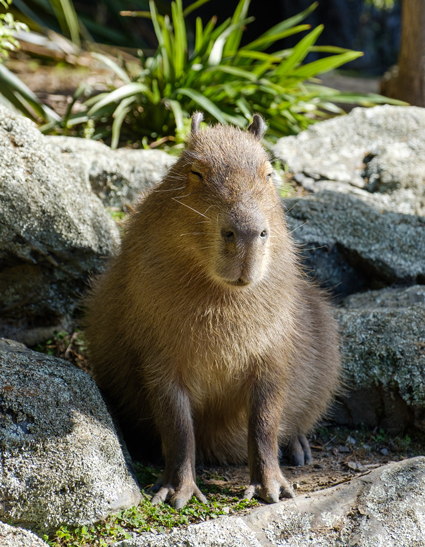The Amazon rain forest is one of the most biodiverse places on Earth and plays a key role in the planet’s carbon and oxygen cycles. Despite its global importance, many aspects of this ecosystem’s history are still a mystery.
Julia Tejada, who recently received her Ph.D. from Columbia University’s Lamont-Doherty Earth Observatory and is now a postdoctoral fellow at the Institut des Sciences de l’Évolution at the Université de Montpellier in France, wants to change this.
Even though the Amazon is a hot spot of biodiversity today, Tejada said even more mammal species lived there in the past. “I wanted to know: What were these mammals doing? How were they partitioning resources?”
But, Tejada said, we need to understand modern ecosystems before we can understand the past.
Recent research from Tejada and colleagues analyzed isotopic signatures in the teeth of present-day Amazonian mammals. These signatures, especially δ13C, a measurement of comparative amounts of carbon-12 and carbon-13, can be used as proxies for diet. And determining what an animal was eating, especially the types of plants it was eating, provides important clues about what type of ecosystem it lived in. This technique is especially useful when researchers want to study ancient rain forest ecosystems, as rain forest plants are rarely preserved in the fossil record.

For nearly 20 years, Tejada said, scientists thought that the presence of animals with ultranegative δ13C diet measurements was necessary for identifying ancient closed-canopy rain forests. But this interpretation was based on analysis of equatorial African mammals; Tejada wanted to see if the same rule applied to Amazonian ecosystems. After all, Africa and South America separated more than 100 million years ago and contain very different species of plants and animals.
The researchers analyzed stable isotopes in the teeth of 45 different species of Amazonian mammals, including monkeys, tapirs, and sloths. Although many species had highly negative values, none had the ultranegative values seen in some of the African animals that have been used to define closed-canopy rain forests.
So what does this mean? “We know that these [Amazonian] mammals are living in a closed-canopy rain forest, so we can no longer use these super-negative values as an indispensable indicator of a closed-canopy rain forest.”
In light of this new finding, Tejada said that scientists may have to reinterpret past data regarding ancient ecosystems. The study was published in the Proceedings of the National Academy of Sciences of the United States of America in October.
Patrick Roberts, an archaeological scientist specializing in stable isotopes at the Max Planck Institute for the Science of Human History who was not involved in the study, said that analyzing stable isotopes in a variety of modern environments is very important—scientists can’t assume that findings from Africa will necessarily apply to rain forests in South America or Southeast Asia, for instance.
Clues in the Pleistocene
But why is that? Why don’t mammals in the Amazon display the ultranegative values found in some African mammals?
This question is especially intriguing because the resources the animals have access to are isotopically similar. “Plants, isotopically speaking, are the same in Africa and South America; they have the same range of values,” said Tejada.
But, said Roberts, “as my Ph.D. supervisor Julia Lee-Thorp used to say, ‘animals aren’t lawnmowers.’ They don’t just eat everything.” Instead, animals have different dietary specializations.
In equatorial Africa, there are a handful of mammals that subsist on the most isotopically negative plants, but in the Amazon, no mammals seem to consume those plants exclusively.
The reason for this may be related to the late Pleistocene extinctions.
“South America, like most continents, experienced a dramatic extinction at the end of the Pleistocene, about 10,000 years ago. And Africa did not experience a dramatic extinction,” said Tejada.
During this time, more than 80% of large-animal (megafauna) genera in South America went extinct. This extinction included several species of horses, giant ground sloths, and elephant-like creatures.
Although Tejada noted that there is not yet sufficient evidence to support this hypothesis, she said it’s possible that the South American animals that specialized in eating highly isotopically negative plants simply went extinct. Since African animals were relatively spared during this extinction, the specialists with ultranegative δ13C values are still around.
Tejada said the new research highlights the need for more studies of stable isotopes in the present, so that we can improve our understanding of how different environments and different variables affect the isotope values, especially in the tropics.
“We need to understand all modern ecosystems, to define them very well, in order to be more confident in our interpretations of the past,” said Tejada.
“It’s very appealing to go to the field or go to a museum collection and drill a bone, take it to the lab, obtain a number, and bingo, we have an interpretation. But we need to be really careful to think about what’s behind the interpretation—can I really trust it? There are systems that have been very well characterized, but there are other ecosystems that are less known. Tropical ecosystems have been severely understudied.”
—Hannah Thomasy (@HannahThomasy), Science Writer






